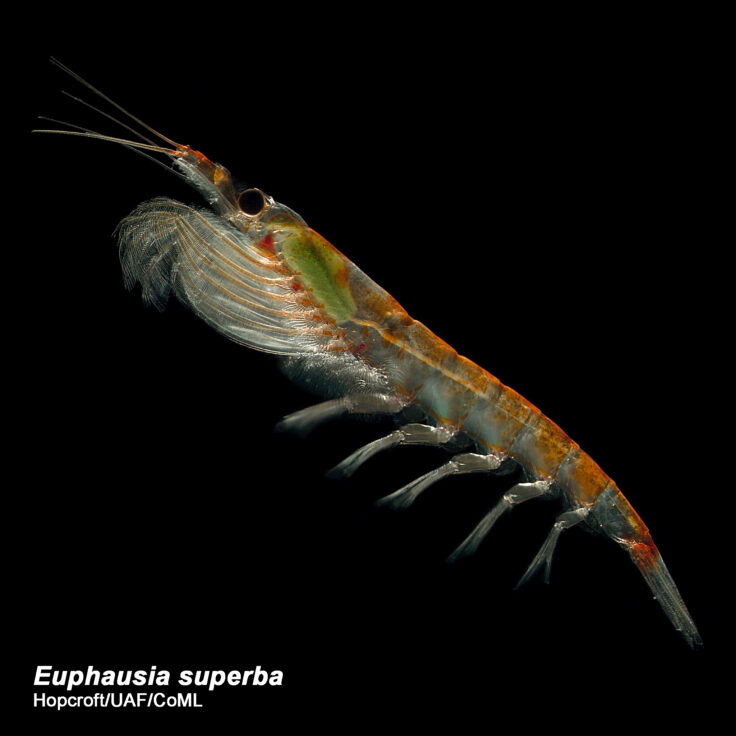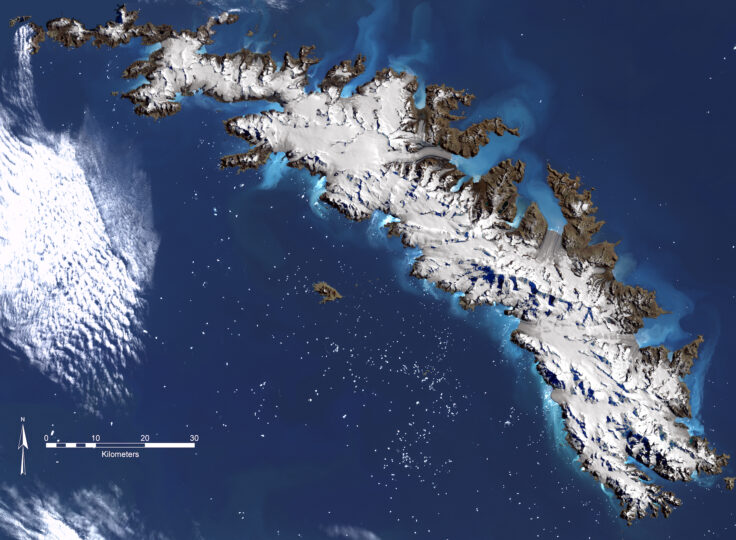Scientists have discovered that Antarctic krill – a tiny shrimp-like crustacean – plays a key role in fertilising the Southern Ocean with iron, which stimulates the growth of phytoplankton, the microscopic plants at the base of the marine food web. This finding is important for understanding the oceans’ capacity for carbon capture.
Reporting this month in the journal Current Biology, a team of European researchers describe how iron-rich rock particles are dissolved in the acidic guts of krill. The discovery is an important step forward in understanding key processes in one of the most biologically-rich regions of our planet.

The research team found that particles that usually sink to the sea-bed are eaten by krill. Within their acidic guts, iron is freed from these particles and can be released in dissolved form into the ocean either directly by krill, by the microorganisms that decompose krill faecal pellets or by whales, seals and penguins that eat them. Krill also produce iron-binding chemicals (called ligands) that prevent the iron from re-attaching onto particles and therefore release it back into the ocean.
This natural iron fertilisation stimulates the growth of phytoplankton – the tiny plants that bloom in the ice-free surface waters during the Antarctic summer and form the base of the Southern Ocean food web. This process also enhances the Southern Ocean’s capacity for natural storage of carbon dioxide.
Lead author Katrin Schmidt, who undertook the research whilst at British Antarctic Survey (BAS) says:
“We know that phytoplankton blooms in the Southern Ocean play a critical role in both sustaining the ecosystem and processing carbon from the atmosphere. It is very likely that in a warming climate, the supply of mineral particles from land-based sources into the ocean will increase and we are keen to investigate how our oceans will respond in the future. This discovery gives us a new understanding of how iron-rich rock particles are being converted into an ocean fertiliser by these remarkable animals. The animals we studied near glacial outlets had three times more iron in their muscles than krill found off the continental shelf. Not only do krill provide a rich source of protein and omega-3 fatty acids for animals and humans, we now know that they play an important role in nutrient and carbon cycles.”
Iron is an essential element for life, but large parts of the world’s oceans experience limited concentrations. Land-derived particles such as fine grains of rock from glacial erosion, windblown dust and river discharges are a potential source of iron for the ocean, but the vast majority is insoluble and sinks to the ocean bed.
Co-author Dr Angus Atkinson from Plymouth Marine Laboratory says:
“It is well-known that krill can recycle iron that is already incorporated in biological matter, but this is the first time that anyone has found that their ability goes beyond recycling. This ability to convert iron into a fertilising solution that boosts coastal and ocean waters changes our view of how the ocean might respond to future change.”
The team analysed data from a research cruise on the BAS-operated RRS James Clark Ross around the sub-Antarctic island of South Georgia during 2010/2011. Phytoplankton blooms downstream of South Georgia were more intensive and longer lasting when there was a high abundance of krill.

Dr Schmidt continues:
“For this study we examined krill but it is very likely that other ocean filter-feeders such as salps, copepods and mysids may share this iron-dissolving mechanism.”
Co-author BAS Biological Oceanographer Dr Sophie Fielding says:
“This finding is essential for understanding the ocean’s capacity for carbon capture. As atmospheric carbon dioxide levels increase, it’s essential for us to understand both the physical and biological mechanisms for fertilising the ocean with iron.”
This research was funded by NERC (Natural Environment Research Council) and DEFRA.
ENDS
Issued by British Antarctic Survey Press Office
Athena Dinar, Senior Communications Manager, email: amdi@bas.ac.uk; tel: +44 1223 221441; mobile: 07909 008516
Paul Seagrove, Press & PR Manager, email: psea@bas.ac.uk; tel: +44 1223 221414; mobile: 07736 921693
Notes to Editors:
Zooplankton gut passage mobilises lithogenic iron for ocean productivity by Katrin Schmidt, Christian Schlosser, Angus Atkinson, Sophie Fielding, Hugh J. Venables, Claire M. Waluda and Eric P. Achterberg is published this month in the journal Current Biology [DOI: http://dx.doi.org/10.1016/j.cub.2016.07.058 ]
Photos of krill and footage of the RRS James Clark Ross are available from the Press Office as above.
About Antarctic krill
Antarctic krill mainly live in the upper water column of the Southern Ocean, but are also found in deeper water and at the seabed. They feed on small plankton organisms and are themselves stable food for fish, penguins, seals and whales. Krill are also harvested by commercial fisheries for human consumption. There are an estimated 100-500 million tonnes of krill in the Southern Ocean – similar to the weight of the world’s human population.
Lead author Katrin Schmidt is now based at SAHFOS (Sir Alistair Hardy Foundation for Ocean Science)
Plymouth Marine Laboratory (PML, www.pml.ac.uk, @PlymouthMarine) is an independent, impartial provider of scientific research and contract services relating to the marine environment. PML focuses on understanding how marine ecosystems function, their role in the Earth system and how we can protect this important environment for the prosperity of future generations. A truly interdisciplinary marine research centre, PML delivers highly innovative research and solutions for national and international marine and coastal programmes. PML’s research is timely, highly relevant to UK and international societal needs and has at its core the mission to contribute to issues concerned with understanding global change and the health and sustainability of marine ecosystems.
The Sir Alister Hardy Foundation for Ocean Science (SAHFOS) is an internationally funded independent research organisation responsible for the operation of the Continuous Plankton Recorder (CPR) Survey. As a large-scale global survey, it provides the scientific and policy communities with a basin-wide and long-term measure of the ecological health of marine plankton. Established in 1931, the CPR Survey is the longest running most geographically extensive marine ecological survey in the world. It has a considerable database of marine plankton and associated metadata that is used by researchers and policy makers to examine strategically important science pillars such as climate change, human health, fisheries, biodiversity, pathogens, invasive species, ocean acidification and natural capital. For further information, visit www.sahfos.ac.uk
